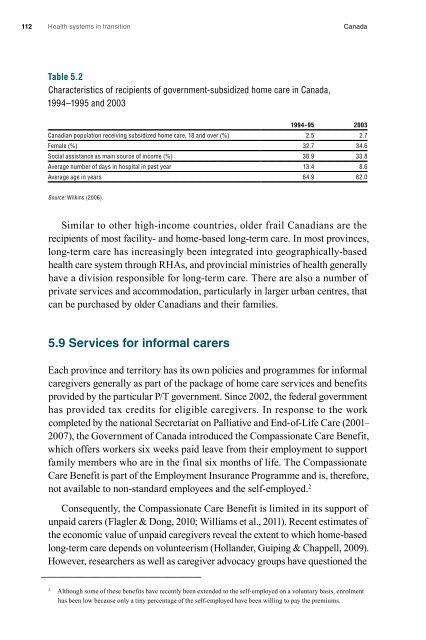Canada - World Health Organization Regional Office for Europe
Canada - World Health Organization Regional Office for Europe
Canada - World Health Organization Regional Office for Europe
Create successful ePaper yourself
Turn your PDF publications into a flip-book with our unique Google optimized e-Paper software.
112<br />
<strong>Health</strong> systems in transition <strong>Canada</strong><br />
Table 5.2<br />
Characteristics of recipients of government-subsidized home care in <strong>Canada</strong>,<br />
1994–1995 and 2003<br />
1994–95 2003<br />
Canadian population receiving subsidized home care, 18 and over (%) 2.5 2.7<br />
Female (%) 32.7 34.6<br />
Social assistance as main source of income (%) 38.9 33.8<br />
Average number of days in hospital in past year 13.4 8.6<br />
Average age in years 64.9 62.0<br />
Source: Wilkins (2006).<br />
Similar to other high-income countries, older frail Canadians are the<br />
recipients of most facility- and home-based long-term care. In most provinces,<br />
long-term care has increasingly been integrated into geographically-based<br />
health care system through RHAs, and provincial ministries of health generally<br />
have a division responsible <strong>for</strong> long-term care. There are also a number of<br />
private services and accommodation, particularly in larger urban centres, that<br />
can be purchased by older Canadians and their families.<br />
5.9 Services <strong>for</strong> in<strong>for</strong>mal carers<br />
Each province and territory has its own policies and programmes <strong>for</strong> in<strong>for</strong>mal<br />
caregivers generally as part of the package of home care services and benefits<br />
provided by the particular P/T government. Since 2002, the federal government<br />
has provided tax credits <strong>for</strong> eligible caregivers. In response to the work<br />
completed by the national Secretariat on Palliative and End-of-Life Care (2001–<br />
2007), the Government of <strong>Canada</strong> introduced the Compassionate Care Benefit,<br />
which offers workers six weeks paid leave from their employment to support<br />
family members who are in the final six months of life. The Compassionate<br />
Care Benefit is part of the Employment Insurance Programme and is, there<strong>for</strong>e,<br />
not available to non-standard employees and the self-employed. 2<br />
Consequently, the Compassionate Care Benefit is limited in its support of<br />
unpaid carers (Flagler & Dong, 2010; Williams et al., 2011). Recent estimates of<br />
the economic value of unpaid caregivers reveal the extent to which home-based<br />
long-term care depends on volunteerism (Hollander, Guiping & Chappell, 2009).<br />
However, researchers as well as caregiver advocacy groups have questioned the<br />
2 Although some of these benefits have recently been extended to the self-employed on a voluntary basis, enrolment<br />
has been low because only a tiny percentage of the self-employed have been willing to pay the premiums.
















